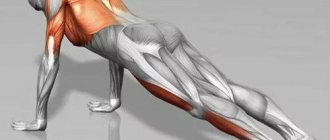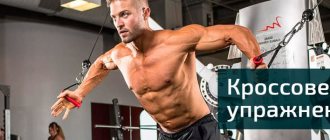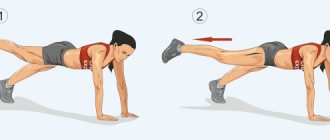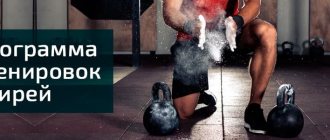Trainers identify 7 main muscle groups: 3 large and 4 smaller. For simplicity, they are not called by anatomical names, but by the part of the body on which they are located. Thus, large ones include the back, legs (meaning hips and buttocks), and chest. Smaller groups for training are shoulders, triceps, biceps, and abs.
“Any muscle needs 3-4 days to recover after exercise,” says Dmitry Lapkin, fitness trainer, sports doctor, and host of the Fit&Well fitness project. — If you correctly distribute muscle groups on different days, you can do the program in 30-40 minutes and be free. Then come to the gym every other day, and while the muscle groups worked last time are resting, load others. This alternation allows you to work out the whole body with maximum weights in 2-4 workouts a week, which will give a good effect.”
We build a program based on experience
Beginners should focus on improving overall physical performance. Strength, endurance, joint mobility and flexibility are more important for their growth than focusing on “lagging deltoids.” The old school of bodybuilding assumes that a physically weak athlete with insufficiently developed motor skills will not be able to build muscle with natural training.
The stages of training a beginner can be represented as:
- Technique development;
- Gaining muscle mass;
- Burning excess fat.
In a fancy fitness center, the trainer will convince the client that he is doing exactly what he came for. He will tell a girl that she will lose weight from box squats and light weight rows, and a skinny guy that he will gain weight from paused push-ups and pull-ups. But the truth is that until the primary motor skill is acquired, the whole body will have to be developed in every training session.
Core muscles
Fullbody is suitable for beginners because, with 3 workouts a week, it allows you to work out squats twice, deadlifts 1-2 times, pull-ups and push-ups every other day, and strengthen your core muscles and back extensors in each workout. A novice bodybuilder will not be injured due to high weights, but will work on the technique of performing basic exercises.
Back extensor muscles
In addition, a fullbody will help him lose weight faster, as it allows him to expend more energy per unit of time. Not all people can immediately begin basic exercises; some need an introductory course in physical education: running at a low pace, static exercises with their own weight, such as planks or lighter versions of burpees.
Burpee
When can you consider yourself “experienced”? The answer to this question varies from person to person. For the purposes of building a split, it is worth switching to training individual muscle groups on different days, when the technique of basic exercises is formed, a person will begin to move without thinking. There is also a subjective criterion - 3 months pass from the start of classes.
In the practice of coaching, the reference point is precisely the 3-4 month cycle. If the client attends classes without skipping, by this time his muscles, ligaments and central nervous system are ready to undergo a classic split.
Which muscle groups should you combine during training?
Above we explained the sports principle. But you can use another: which groups are the most difficult to train? Let's distribute them from heaviest to lightest.
- Legs usually require the hardest training and the most weights. The muscles of the buttocks and thighs together are the largest and strongest muscles in the body. Since they are used when walking, they are also the most trained for a beginner. Therefore, in order to really load and work them out efficiently, you need the heaviest weights, strength and concentration.
- The back is the second largest muscle group. It ensures, among other things, good posture and a healthy spine. With weak back muscles, the everyday load (for example, lifting a bag) falls on the ligaments of the spine and intervertebral discs, which is why serious weights and exercises are also needed to work it out. If you're learning the deadlift, keep in mind that although this exercise primarily targets the back, it loads the legs much like a squat.
- The chest is not the largest group in terms of volume, which does the opposite work to the back muscles. It definitely needs to be trained no less than your back, otherwise your muscle mass will not be balanced, and your back muscles will pull your spine back too much.
- The shoulders work together with the back and chest. Developed deltoids protect the shoulder joint from injury. This is the only joint in the human body in which a bone does not rest on another bone, but rather two bones touch and rest on ligaments. Powerful shoulder muscles keep this ligament from being displaced or torn during sudden or unusual movements of the shoulder.
- The triceps is an extensor muscle located on the back of the arm from the shoulder to the elbow. It consists of 3 muscle bundles and is an antagonist of the biceps, which is almost 2 times larger in size. Therefore, it is impossible to increase the size of the biceps without properly pumping the nearest triceps muscle.
- The biceps is an extensor muscle located on the other side of the arm from the triceps and does the opposite job. The biceps consists of two muscle bundles. Thanks to its location, it visually increases the size of the hand.
- The press is a kind of muscle group that we described above.
As you can see, assigning muscle groups to exercises is a fairly creative process with no hard and fast rules. You can try different combinations and feel what suits you best personally.
Training frequency and planning
Many people can only visit the gym twice a week. In this case, it is first recommended to do 2 workouts for the whole body, with a different set of exercises:
The first is knee-dominant (squat, leg press, lunge) leg exercises, upper body presses, and core training.
The second is pelvic-dominant exercises for the legs (pull-ups and bend-overs with a barbell), pull-downs for the back (in a bend-over, and if possible, deadlifts in a classic position), and exercises for the biceps.
Fullbody VS split
After 2-3 months have passed, and the weight limit has been reached, you can switch to a split based on the “top-bottom” principle. What you don't need to do is give up working your leg muscles. Some people stop lifting their legs so they can spend more time on their chest and back, but this is wrong. The legs are a powerful support in the press, and the most important lever for lifting the weight. Their insufficient development can cause injury both at home and in the gym. There is also a theory that it is difficult to create an anabolic background in the body if you do not do basic exercises.
When visiting the gym for three days, they usually alternate workouts 1 and 2 in the fullbody version, without reference to the week. As time passes, they switch to one of the classic splits:
- Chest-triceps, back-biceps, legs-deltoids, abs in every workout;
- Chest-biceps, back-triceps, legs-deltoids, abs.
Weaknesses and strengths of an athlete
In bodybuilding, it is customary to consider muscle groups that do not grow well as weaknesses. And in strength sports there are deficiencies in the motor pattern (habits) and structural features of the body that do not allow for adequate technique.
Example: an athlete has long legs, hips, a narrow pelvis, and long arms. Her goal is to tone up her butt while maintaining a low body fat percentage. From the point of view of strength work, it will be more difficult for her to arrange the squat technique so that the full amplitude of the work is achieved. From a bodybuilding point of view, her buttocks can either lag behind or respond normally, because there are many other exercises besides the squat.
When creating a split for a beginner, it is assumed that he has weak motor skills, and not “lagging muscles.” Therefore, in some cases, there may be 3 squats per week, with 1 deadlift, and pumping the back every day.
Advanced athletes should work on lagging muscle groups first. Doing “specialization”, that is, including pumping up some groups 2 times a week in the training plan, makes sense with an adequate daily routine, good recovery, and developed motor skills.
Physical weaknesses
When drawing up a program for combining muscle groups, it is necessary to take into account the athlete’s strengths and weaknesses. The training should begin with less pumped muscles, so that the main energy is spent on high-quality work with them. Next, you can move on to strengthening groups that are in good shape.
Calculate your ideal sports weight!
Endurance is trained gradually. Therefore, over time, it will be possible to make amendments to the training schedule: change the pattern of classes and days off, the sequence of work, add exercises, increase weights or the number of repetitions and approaches.
Rest and recovery
Ideally, training should occur at the peak of supercompensation. It occurs 36-72 hours after the main strength work. It is advisable for a beginner to train the whole body every other day because he does not use high weights in his exercises, which can significantly affect the condition of the musculoskeletal system. In this training, each major muscle group is pumped with two, maximum three exercises. The volume does not exceed 6-12 working approaches per group.
More advanced clients may want to train a muscle group once a week as they perform a larger volume of work. They usually perform up to 5 exercises, some more.
For girls
Girls can stick to strength training without fear of negative consequences for their figure. On the contrary, such physical activity will help you achieve beautiful shapes, excellent posture and have a positive effect on the condition of your skin.
Together with proper nutrition, strength training will save time by eliminating the need to do hours of daily cardio exercise.
The main goal in this case is uniform muscle development, since women, due to their specific physique, usually suffer from triceps, back of the thighs and buttocks. Therefore, it makes sense to include exercises for general tone, and work on target areas by combining exercises on the legs and buttocks on one day, and on the back, arms and shoulders on another day. Perform 2-3 exercises per muscle group, using 2-3 sets of 10-12 repetitions.
Types of combination
Exercises in the training program can be combined:
- Fullbody – working out the whole body;
- Split – muscle group on a training day;
- Skill development - training is built around an exercise and the auxiliary movements necessary for adequate strength in it.
Important: the latter approach is justified from the point of view of biomechanics more than bodybuilding splits; Western training organizations (NASM, ISSA) proceed from the fact that the trainer will work on skills with the fitness client.
There is nothing wrong with splits either; they are great for gaining muscle mass and building an athletic body. To unlock your potential, it is necessary to take into account the individual characteristics of recovery.
There are several options for working out the whole body:
- Learning basic exercises. Take a squat or deadlift, and add a bench or standing press, a simple or Australian pull-up, and some light shoulder swings and biceps curls. Exercises alternate by day, an adequate breakdown was discussed above;
- Strengthening the muscles and ligaments of a person with “motor problems”. At each training session, a person performs the same set of exercises in the machines. Typically these are leg presses, hyperextensions, chest and shoulder presses, cable pull-downs or gravitron pull-ups, seated rows, and abdominal exercises;
- Fullbody with an “emphasis” on future CrossFit or functional all-around activities. In addition to studying the squat and deadlift, cardiovascular training consisting of high-repetition squats, sprinting, etc. is added.
Fullbody training alternates between a training day and a rest day.
Top one day, bottom one day training is typical of American bodybuilding and powerlifting. Entire methodological systems have grown up around them, for example, Brandon Lilly’s “Cube”.
Brandon Lilly - creator of the Cube system
Their advantages:
- They work well if you need mass and strength;
- Allows you to develop the necessary skills for any sport;
- Do not put too much stress on joints and ligaments;
- Suitable for men and women.
For a natural athlete, this option has almost no downsides. But in professional bodybuilding it often does not give the desired result, since there is simply no time to develop individual small muscle groups.
A leg press-pull split usually looks like this:
Day 1 – bench press, triceps, anterior deltoid, and middle deltoid exercises;
Day 2 – deadlift, or bent-over row, working the back, biceps, rear deltoids;
Day 3 – Squat and Leg Workout
You can do shoulder exercises on leg day if you don’t have the strength to add them to your plan in other workouts, or they fall behind. This option is convenient for most exercisers, as it involves visiting the gym 3 times a week.
This scheme is for those who want to pump their arms on a separate day, and see the meaning in this. Typically the breakdown is like this:
Day 1 – chest and middle delta;
Day 2 – back and rear deltoid;
Day 3 – legs and front deltoid;
Day 4 – biceps and triceps (they are antagonists, this is what gives the split its name)
A suitable option for more advanced athletes who feel that their arms are lagging behind.
A five-day split is for advanced athletes whose level is close to professional. People who are losing weight often train in this style, simply because it motivates them to go to the gym every day and spend more calories.
Day 1 - legs, front thighs;
Day 2 - chest and triceps;
Day 3 - back and biceps;
Day 4 - legs, back of thighs;
Day 5 - deltas.
Other options for a five-day split are possible, depending on the lagging muscle groups.
How to combine muscle groups during training
When exercises on one muscle group are replaced by loads on others, each subsequent exercise leaves approximately 30% less strength than the previous one. Therefore, the program usually includes exercises for large muscles (for example, the back), and then for 1 or 2 small ones (for example, shoulders and biceps). Advanced athletes also combine two large muscle groups (for example, the back and legs), but at the same time the second group in the training is worked “lightly” - with light weights.
“This approach allows you to pay maximum attention to each muscle group on those days when you target it first in training,” explains Dmitry Lapkin. — This also minimizes the risk of entering a state of overtraining. Having done your best in the first exercises, you should not repeat this again and again in order to work out the remaining muscle groups just as effectively and fully.”
Thus, distributing muscle groups over different days is less exhausting than training them all in one session, and requires less time. At the same time, progress will be even higher due to balanced load distribution. This is convenient for working people who have a lot to do besides the gym.











